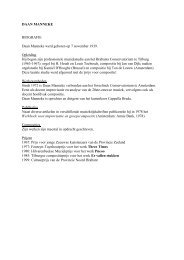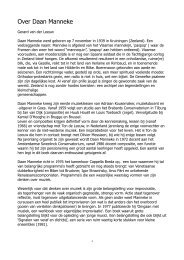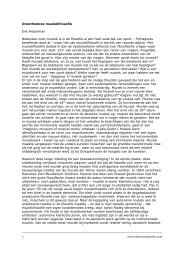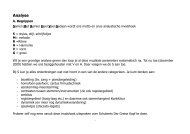Anton Webern and the influence of Heinrich Isaac
Anton Webern and the influence of Heinrich Isaac
Anton Webern and the influence of Heinrich Isaac
Create successful ePaper yourself
Turn your PDF publications into a flip-book with our unique Google optimized e-Paper software.
Example 1: <strong>Anton</strong> <strong>Webern</strong>, Five Sacred Songs Op. 16, movement V.<br />
Such a distinctive characterisation <strong>of</strong> <strong>the</strong> different musical ‘layers’ can also be<br />
seen in Choralis Constantinus. Though it is maybe less striking than in <strong>Webern</strong>’s<br />
work, his comment that <strong>Isaac</strong> made ‘each voice an independent, highly individual<br />
entity’ (<strong>Webern</strong>, 1958: 24) shows that <strong>Webern</strong> had noted this tendency during his<br />
studies. A pertinent example from <strong>Isaac</strong>’s work occurs in Mass IV Purificationis<br />
Mariae (p.33, system 4) <strong>of</strong> Choralis Constantinus, where <strong>the</strong>re is ano<strong>the</strong>r double-<br />
canon in which each <strong>of</strong> <strong>the</strong> canons has a distinct intervalic character. Whereas canon I<br />
(altus <strong>and</strong> discantus) consists largely <strong>of</strong> stepwise motion, major <strong>and</strong> minor seconds,<br />
canon II (bassus <strong>and</strong> tenor) employs larger intervals, notably descending thirds (major<br />
<strong>and</strong> minor) <strong>and</strong> ascending perfect fourths.<br />
Example 2: <strong>Heinrich</strong> <strong>Isaac</strong>, Choralis Constantinus, Book II, Purificationis Mariae.<br />
5





![Schubert, Winterreise: Einsamkeit [PDF] - bestmusicteacher.com](https://img.yumpu.com/21166489/1/190x135/schubert-winterreise-einsamkeit-pdf-bestmusicteachercom.jpg?quality=85)

![Schubert, Winterreise: Die Nebensonnen [PDF] - Bestmusicteacher ...](https://img.yumpu.com/20295219/1/190x135/schubert-winterreise-die-nebensonnen-pdf-bestmusicteacher-.jpg?quality=85)
